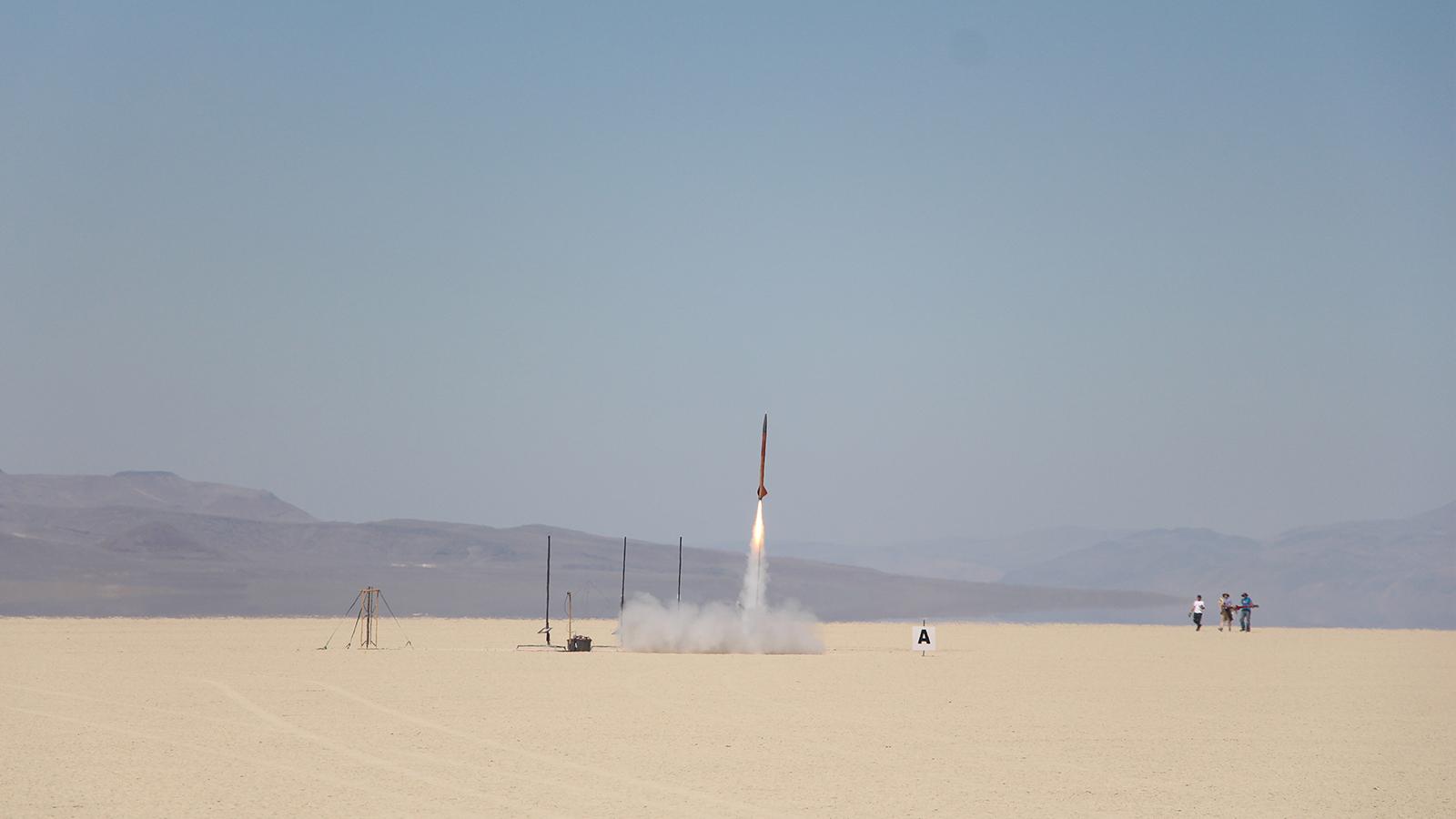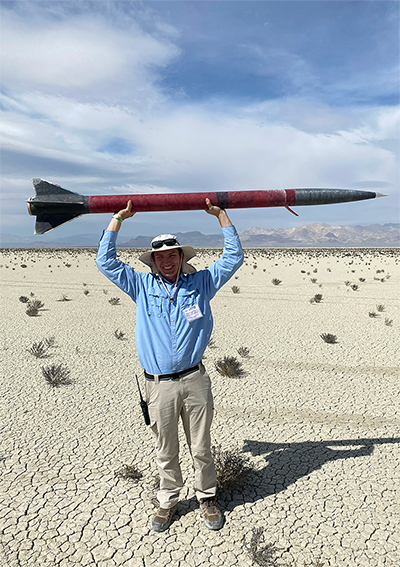Six aerospace students hope to set a new record
January 29, 2024

Noah Miranda ’25 is no stranger to adversity — and soaring success. It’s all part of being a rocket scientist in the making.
On a recent trip to Nevada’s Black Rock Desert with five other members of Rensselaer Polytechnic Institute’s Rocket Society student club, Miranda watched with high hopes as one of the team’s 16-foot tall, 70-pound rockets shot into the perfectly blue desert sky.
At first, the flight was “as textbook as you can get,” he said. “We’re watching the rocket go up, and it’s coasting beautifully. At 16,000 feet, the first parachute pops out, and I’m hyped up. But then, as I watch the rocket on GPS, I see it’s not slowing down. Something was wrong. The second parachute didn’t deploy.”
The bad news: The rocket crash landed about 2 miles away from the launch site.
The good news: The rocket, which Miranda designed and fabricated himself, was intact and, with a few minor repairs, was able to fly again shortly after — this time with both parachutes deploying.
The even better news: The team, which includes aerospace majors Lucas Long ’25, Katelyn Morgan ’26, Rowan Jordan ’26, Constantine Childs ’25, and Ella Wu ’26, had several successful launches that day while competing with other rocketry teams comprised of other college students and hobbyists. They even launched a rocket that reached more than 42,000 feet, a team first.

The group is already hard at work preparing for launches in 2024 and 2025. They’re working toward a big dream: a rocket that reaches well beyond the Kármán Line — the point 330,000 feet above sea level that marks the end of Earth’s atmosphere and the beginning of outer space.
“The design we’re developing is projected to reach around 375,000 feet,” Miranda said.
No university team has ever sent a rocket that high. The RPI team, a research group within the Rensselaer Rocket Society called the Ascendant Research Group, or the Ascendants for short, hopes to be the first.
The keys to their success? Dedicated mentors, engineering know-how, and a do-it-yourself attitude.
“We make and design pretty much every aspect of our rockets. We do our own R&D. Very little of what we use is off-the-shelf. In the world of amateur rocketry, that’s pretty unusual,” said Morgan.
That R&D includes engineering the solid propellant that blasts their rockets into the air, with some expert help from RPI faculty, of course.
Kevin Housley, Ph.D., lecturer in the Department of Mechanical, Aerospace, and Nuclear Engineering, is the Rensselaer Rocket Society’s adviser and provides guidance on sourcing supplies and safe propellant fabrication, storage, and use.
In the lab of Matt Oehlschlaeger, Ph.D., professor of aerospace engineering, the Ascendants synthesize and test ammonium perchlorate-based propellants, using tools ranging from an industrial stand-mixer to a vacuum chamber that removes air bubbles from the fuel.
But the learning doesn’t stop there. Before they use a new propellant, the students conduct a characterization burn, which measures and records the pressure exerted on the rocket’s chamber as the propellant combusts. This data helps the group predict the burn rate of the propellant at any given chamber pressure, an important parameter that can only be determined experimentally.
Propulsion is just one of several elements The Ascendants must engineer and perfect. They apply what they’ve learned in the classroom about aerospace design, physics, chemistry, computer modeling, statistics, and manufacturing to produce a rocket that will not only fly but also come back to Earth in one piece.
“What this team has been able to accomplish in a relatively short amount of time is truly impressive,” said Oehlschlaeger, who directs the RPI aerospace program and serves as associate dean for academic affairs in RPI’s School of Engineering. “I’m so proud of how they continuously challenge themselves and have channeled their passion for rocketry into invaluable, hands-on learning experiences.”
“That experience will serve them well when they enter the aerospace industry in the coming years,” said Shekhar Garde, dean of RPI’s School of Engineering.
“With NASA’s upcoming Artemis missions and commercial space flights taking off, now is a great time for students to be learning rocketry first-hand,” Garde said. “RPI has always been at the forefront of space research and technology, from RPI alumnus and president George Low, who was instrumental in the Apollo missions, now to RPI alumnus Reid Wiseman, commander of the Artemis 2 mission. Today, our faculty are designing trajectories for spaceships, exploring exoplanets, and studying human physiology in space — the future is bright for this field.”
To make a gift to the Rensselaer Rocket Society to help support Project: Ascendant, visit the Rensselaer Giving website.